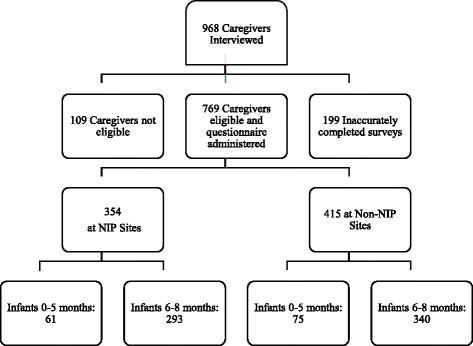The potential effectiveness of the nutrition improvement program on infant and young child feeding and nutritional status in the Northwest and Southwest regions of Cameroon, Central Africa
- PMID: 27846828
- PMCID: PMC5109805
- DOI: 10.1186/s12913-016-1899-z
The potential effectiveness of the nutrition improvement program on infant and young child feeding and nutritional status in the Northwest and Southwest regions of Cameroon, Central Africa
Erratum in
-
Erratum to: The potential effectiveness of the nutrition improvement program on infant and young child feeding and nutritional status in the Northwest and Southwest regions of Cameroon, Central Africa.BMC Health Serv Res. 2017 Feb 24;17(1):165. doi: 10.1186/s12913-017-2109-3. BMC Health Serv Res. 2017. PMID: 28235405 Free PMC article. No abstract available.
Abstract
Background: Despite the recent international focus on maternal and child nutrition, little attention is paid to nutrition capacity development. Although infant feeding counselling by health workers increases caregivers' knowledge, and improves breastfeeding, complementary feeding, and children's linear growth, most of the counselling in sub-Saharan Africa is primarily conducted by nurses or volunteers, and little is done to develop capacity for nutrition at the professional, organizational, or systemic levels. The Cameroon Baptist Convention Health Services Nutrition Improvement Program (NIP) has integrated a cadre of nutrition counselors into prevention of mother-to-child transmission of HIV programs, infant welfare clinics, and antenatal clinics to improve infant and young child feeding practices (IYCF). The study objective was to evaluate the effects of NIP's infant feeding counselors on exclusive breastfeeding (EBF), complementary feeding (CF), and children's linear growth.
Methods: A cross-sectional evaluation design was used. Using systematic random sampling, caregivers were recruited from NIP sites (n = 359) and non-NIP sites (n = 415) from Infant Welfare Clinics (IWCs) in the Northwest (NWR) and Southwest Regions (SWR) of Cameroon between October 2014 and April 2015. Differences in EBF and CF practices and children's linear growth between NIP and non-NIP sites were determined using chi-square and multiple logistic regression.
Results: After adjusting for differences in religion, occupation, and number of months planning to breastfeed, children were almost seven times (Odds Ratio [OR]: 6.9; 95% Confidence Interval [CI]: 2.30, 21.09; β = 1.94) more likely to be exclusively breastfed at NIP sites compared to non-NIP sites. After adjusting for differences in occupation, religion, number of months planning to breastfeed, rural environment, economic status, attending other Infant Welfare Clinics, and non-biological caregiver, children were five times more likely to be stunted at non-NIP sites compared to NIP sites.
Conclusion: Training a cadre of nutrition counselors is one approach towards increasing nutrition human resources to implement nutrition interventions to improve maternal and child nutrition. In this research project, the study design did not allow for conclusive results, but rather suggest IYCF counseling provided by nutrition counselors was effective in increasing EBF and reduced the risk of stunting in children 6-8 months.
References
-
- Sodjinou R: Assessing Capacity: The need to invest in nutrition capacity development in the West Africa region. Washington DC; 2014.http://www.globalnutritionreport.org/files/2014/11/gnr14_tn_n4g_08sodjin.... Accessed 6 Aug 2015.
MeSH terms
LinkOut - more resources
Full Text Sources
Other Literature Sources
Medical
Miscellaneous


